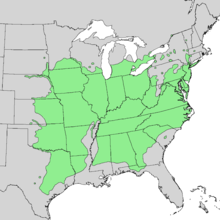| Eastern black walnut | |
|---|---|

| |
| Leaves and fruit | |
| Scientific classification | |
| Kingdom: | Plantae |
| Clade: | Tracheophytes |
| Clade: | Angiosperms |
| Clade: | Eudicots |
| Clade: | Rosids |
| Order: | Fagales |
| Family: | Juglandaceae |
| Genus: | Juglans |
| Section: | Juglans sect. Rhysocaryon |
| Species: | J. nigra
|
| Binomial name | |
| Juglans nigra | |

| |
| Natural range | |
Juglans nigra, the eastern American black walnut, is a species of deciduous tree in the walnut family, Juglandaceae, native to central and eastern North America, growing mostly in riparian zones.
Black walnut is susceptible to thousand cankers disease, which provoked a decline of walnut trees in some regions. Black walnut is allelopathic, releasing chemicals from its roots and other tissues that may harm other organisms and give the tree a competitive advantage, but there is no scientific consensus that this is a primary competitive factor.
Black walnut is an important tree commercially, as the wood is a deep brown color and easily worked. Walnut seeds (nuts) are cultivated for their distinctive and desirable taste. Walnut trees are grown for lumber and food, and processors have found additional markets for even the tough outer hulls by finely grinding them for use in products such as abrasive cleansers. Many cultivars have been developed for improved quality wood or nuts. In 2017, the United States Department of Agriculture valued U.S. walnut timber at $530 billion. A significant amount is grown in Missouri.
- ^ Stritch, L. (2018). "Juglans nigra". IUCN Red List of Threatened Species. 2018: e.T62019712A62019714. doi:10.2305/IUCN.UK.2018-1.RLTS.T62019712A62019714.en. Retrieved 19 November 2021.
